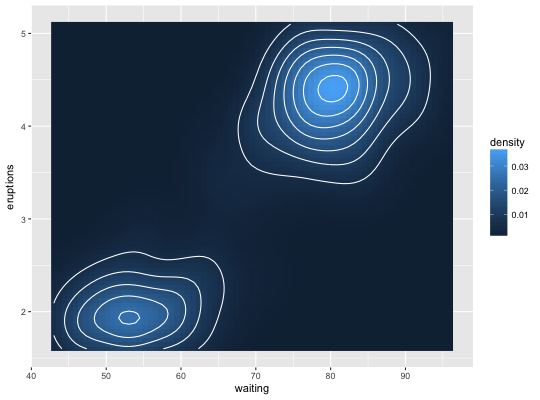2d contours of a 3d surface
ggplot2 can not draw true 3d surfaces, but you can use geom_contour
and geom_tile to visualise 3d surfaces in 2d. To be a valid
surface, the data must contain only a single row for each unique combination
of the variables mapped to the x and y aesthetics. Contouring
tends to work best when x and y form a (roughly) evenly
spaced grid. If you data is not evenly spaced, you may want to interpolate
to a grid before visualising.
geom_contour(mapping = NULL, data = NULL, stat = "contour", position = "identity", ..., lineend = "butt", linejoin = "round", linemitre = 1, na.rm = FALSE, show.legend = NA, inherit.aes = TRUE) stat_contour(mapping = NULL, data = NULL, geom = "contour", position = "identity", ..., na.rm = FALSE, show.legend = NA, inherit.aes = TRUE)
Arguments
| mapping | Set of aesthetic mappings created by |
|---|---|
| data | The data to be displayed in this layer. There are three options: If A A |
| stat | The statistical transformation to use on the data for this layer, as a string. |
| position | Position adjustment, either as a string, or the result of a call to a position adjustment function. |
| ... | other arguments passed on to |
| lineend | Line end style (round, butt, square) |
| linejoin | Line join style (round, mitre, bevel) |
| linemitre | Line mitre limit (number greater than 1) |
| na.rm | If |
| show.legend | logical. Should this layer be included in the legends?
|
| inherit.aes | If |
| geom | The geometric object to use display the data |
Aesthetics
geom_contour understands the following aesthetics (required aesthetics are in bold):
xyalphacolourgrouplinetypesizeweight
Computed variables
- level
height of contour
See also
geom_density_2d: 2d density contours
Examples
# Setting bins creates evenly spaced contours in the range of the data v + geom_contour(bins = 2)v + geom_contour(bins = 10)# Setting binwidth does the same thing, parameterised by the distance # between contours v + geom_contour(binwidth = 0.01)v + geom_contour(binwidth = 0.001)v + geom_contour(colour = "red")








